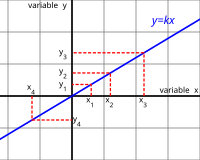Proportionality (mathematics)

Proportionality in math means that two or more things are related to each other in a certain way. For example, if you have two bags of marbles and one bag has twice as many marbles as the other, then the number of marbles in one bag is proportional to the number of marbles in the other bag.
In order to understand proportionality, you need to know about ratios. A ratio is a way of comparing two quantities by expressing the relationship between them in terms of a fraction. For example, if you have 3 red marbles and 2 blue marbles, the ratio of red marbles to blue marbles is 3:2. This means that for every 3 red marbles, there are 2 blue marbles.
Proportionality is when two ratios are equivalent, meaning that they have the same relationship between the quantities being compared. This is shown by a symbol that looks like an equal sign with a squiggly line on top (≈). For example, if you have 6 red marbles and 4 blue marbles, the ratio of red marbles to blue marbles is 6:4, which simplifies to 3:2. If you compare this ratio to the ratio of 3 red marbles to 2 blue marbles, you'll see that they have the same relationship, so they are proportional.
Proportional relationships can be expressed in various ways, such as in a table or a graph. The key thing to remember is that if the ratios are equivalent, then the quantities being compared are proportional to each other.
In order to understand proportionality, you need to know about ratios. A ratio is a way of comparing two quantities by expressing the relationship between them in terms of a fraction. For example, if you have 3 red marbles and 2 blue marbles, the ratio of red marbles to blue marbles is 3:2. This means that for every 3 red marbles, there are 2 blue marbles.
Proportionality is when two ratios are equivalent, meaning that they have the same relationship between the quantities being compared. This is shown by a symbol that looks like an equal sign with a squiggly line on top (≈). For example, if you have 6 red marbles and 4 blue marbles, the ratio of red marbles to blue marbles is 6:4, which simplifies to 3:2. If you compare this ratio to the ratio of 3 red marbles to 2 blue marbles, you'll see that they have the same relationship, so they are proportional.
Proportional relationships can be expressed in various ways, such as in a table or a graph. The key thing to remember is that if the ratios are equivalent, then the quantities being compared are proportional to each other.
Related topics others have asked about:
